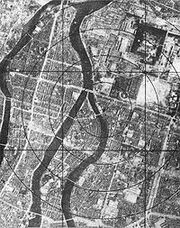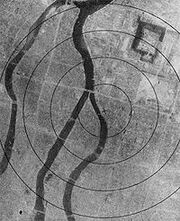
Hiroshima before the atomic bomb.
Located some 500 miles from Tokyo,[1] Hiroshima was a large manufacturing city in Mainland Japan as well as the 7th biggest city with a population of approximately 350,000 at the time of 1945. Hiroshima was to be the first of the two instances of the use of atomic weapons during war.
History[]
After research from the Manhattan project, and the trinity testing the use of A-Bombs were ready to be deployed. Being delivered a warning to surrender or face a weapon of mass destruction known as the Potsdam Declaration, the plans to drop the bomb were in motion. On August 6th at 8:15am local time the Uranium bomb Little Boy was dropped from a modified B-29 bomber named the Enola Gay,[2] flying at an altitude of 31,600 ft, and travelling at a ground speed of 328 mph, on the city of Hiroshima.[3] Detonated in the air directly above the city centre,[N 1] the bomb was equal to 22-kilotons or 12,000 to 15,000 tons of TNT.
The blast, which generated tempretures up to 300,000 celsius for 1/10,000th of a second, vaporised every building within a 2,000 yard radius, as well as every wooden building within 1.2 miles, equating to the destruction of 5 square miles, or 63 percent of the city's 76,000 buildings. This was followed by a hugh mushroom shaped cloud rising 50,000ft over the city.[1]
An estimated 80,000 people were instantly killed by the bomb's tremendous pressure, explosion, and heat, with the explosion setting fire to the debris.

After the bomb.
The heat of the blast was so immense people could become immediately vaporized if within a close enough proximity of the bomb. People in multiple miles away in the surrounding countryside could also become picked up from the immense blast wave of the bomb and thrown into objects, often resulting in injury. After an immense initial destruction the effects of radiation began to take hold on the survivors of the initial explosion.
The radiation spread over a large area after being spread by the iconic mushroom cloud, and would later claim many lives. Although estimations vary greatly due to death by radiation being difficult to exactly identify it is thought an estimated 90,000 to 200,000 people died after the initial bombing being much larger than the deaths caused by the initial blast. Although not all of these deaths were direct results of radiation many of them were whether from deaths within a few days or up to cancer contracted several years later.[2]
Notes[]
References[]
- ↑ 1.0 1.1 1.2 Roberts, Andrew. The Storm of War - A new history of the Second World War. Penguin Books. ISBN 978 0 141 02928 3. (2010). Page 575
- ↑ 2.0 2.1 http://www.history.com/topics/bombing-of-hiroshima-and-nagasaki
- ↑ 3.0 3.1 Green, William. Famous Bombers of the Second World War. Purnell Book Services. 1975. Page 84
